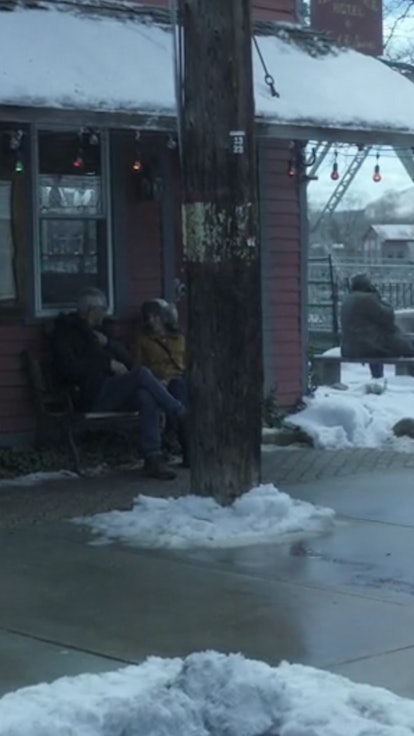Dexter Morgan — I mean, Jim Lindsay — has traded in the sandy beaches of Miami, Fla., for the icy woods of Iron Lake, N.Y., in Dexter: New Blood. But when Dexter ended back in 2013, Dexter moved to Oregon in the finale — not New York. And even though Dexter's voiceover is back, the premiere of the Showtime revival didn't give any explanation about how he went from the Beaver State to the Empire State.
In the official Dexter podcast, Wrap-Up, executive producer Scott Reynolds and New Blood showrunner Clyde Phillips discussed Dexter's move to Iron Lake. Phillips, who was part of the first four seasons of the original Dexter, said he wanted the revival's location "to be a small, cold town that had nothing to do with Miami."
While the new setting is a stark (winter is coming) contrast to the sunny metropolis of Miami, what's so strange about the relocation is that Oregon could easily have had a small, remote town with plenty of woods and cold winters for Dexter to live in. But slightly bafflingly, the revival decided to put good old Jimbo in a fictional sleepy upstate New York town (which was really filmed in Massachusetts) rather than just keep him in Oregon.
While the small town, wintery vibes are important to New Blood, the specific location of Oregon held some significance in the original finale. At San Diego Comic-Con, Reynolds — who served as supervising producer for the final season — explained why the original show chose to end in Oregon. As Polygon reported, Reynolds said that the FBI reported that there were around 15 serial killers in that Pacific Northwest area at the time. Plus, Dexter being surrounded by chainsaws as a lumberjack meant he was being constantly reminded of how his mother died. So the show wanted to leave the audience wondering if Dexter was back to his old, serial killing ways. (Fans on Reddit also caught references to Oregon throughout the original series, which makes the ending — though still divisive — a little bit more interesting.)
But Phillips — who had left Dexter long before the final season — added at Comic-Con, "One of the things that we all agreed on ... is that [New Blood] not be Dexter Season 9. That we acknowledge that this is not the next moment after the lumberjack moment. That we acknowledge the truth, that time has passed, almost 10 years have passed, and we pick up Dexter in another place, in another world actually, as far away from Miami as possible." According to CheatSheet, Phillips said a similar thing during a Television Critics Association panel. "This is not Dexter next morning in Miami after a hurricane, or Dexter next morning in Oregon, or wherever that lumberjack, lumberyard was," the showrunner said.
Perhaps the move to New York is because they wanted to have a jerky Wall Street guy show up to push Dexter to kill again. Or because they wanted to feature the Indigenous Peoples of Seneca Nation. Though, yet again, those storylines could have been done in Oregon with a Silicon Valley tech guy and using one of the Native American tribes located in the state. So maybe it all comes down to the fact that New Blood showrunner Phillips wasn't a part of the original lumberjack finale and wanted to end the show the way he envisioned with this 10-part miniseries.
Although Dexter's cross-country relocation didn't get mentioned in the New Blood premiere, "Cold Snap," Phillips has made it seem that it will come up sometime on the show. On the Wrap-Up, he mentioned how Dexter's son Harrison "has traveled the world to find his father" after tracking him "from Argentina to Miami to Oregon to Iron Lake, N.Y." With Dexter welcoming Harrison into his New York home at the end of the New Blood premiere, this father and son team could briefly cover the backstory that's missing between the original series and the revival in a future episode. But even if the Morgan men don't explicitly outline the move, New Blood established that Dexter is a lumberjack no more.
Images: Showtime




